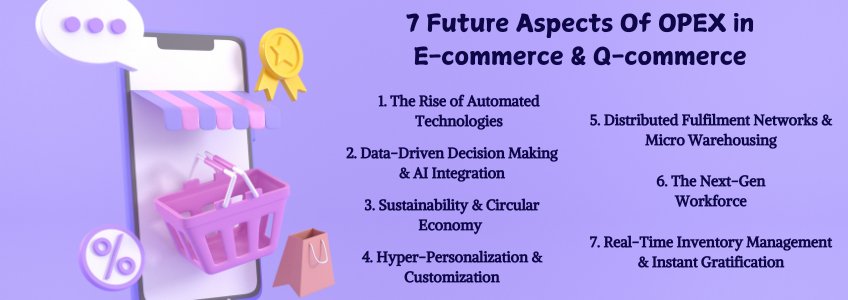
Introduction
As E-commerce and Q-commerce continue to reshape the retail landscape, businesses are increasingly seeking innovative solutions to optimize their operations. In such a scenario it is necessary to gauge the future of operational excellence (OPEX) in the E-commerce and Q-commerce business sectors.
It is already evident that the next era of OPEX would demand a paradigm shift, moving beyond incremental improvements to proactive disruption. The rise of Q-commerce, with its emphasis on lightning-fast deliveries and hyper-local fulfilment, has further underscored the need for agility and automation in operational strategies.
This blog post explores the key trends and challenges shaping the future of OPEX in the E-commerce and Q-commerce industries.

1. The Rise of Automated Technologies
In Q-commerce, where delivery times are measured in minutes rather than hours, relying on manual processes will be a bottleneck. Technical advancements like drones, autonomous delivery vehicles, and robotic process automation (RPA) are going to reshape the logistics landscape.
OPEX will evolve once we understand that efficiency doesn’t mean stripping away all human elements. The future is in hybrid models where humans and machines work in tandem. The challenge is not the automation itself but in knowing what to automate and how to use it to enhance customer relationships.
Ad Hoc Atelier, an Italian ecommerce platform offering exclusive clothing collections and accessories, used live chat tools to increase sales. By implementing live chat, they managed to increase their conversion rate from 0.35% to 0.9%1.
2. Data-Driven Decision Making and AI Integration

Predictive analytics powered by AI will be at the heart of OPEX strategies. Real-time data on consumer behavior, market shifts, and supply chain disruptions will enable businesses to make decisions faster and smarter.
The future of operational excellence in both e-commerce and Q-commerce isn’t just about collecting data but about synthesizing it to gain actionable insights.
AI is needed not only to give insights but also to learn from patterns to predict market demands. AI can help to automate inventory management, and even enhance customer personalization.
Walmart uses AI to automate inventory management and enhance customer personalization. Their AI-driven operations help them adjust the supply chain, fulfilment process, and delivery times based on the unique needs of each customer.
3. Sustainability and Circular Economy Models
Sustainability is becoming non-negotiable for operational strategies and this will go beyond just carbon footprint reductions.
A circular economy is one where products are designed with their lifecycle in mind. In such cases practicing sustainability can help one to build a future where customers send back old products, and their business’ operation seamlessly integrates that into its supply chain, reducing waste and creating new revenue streams.
So, instead of just delivering fast, Q-commerce and E-commerce will also be reducing environmental impact. That could be a game-changer, especially for this industry sector, where packaging waste is a significant issue.
IKEA has launched a program where customers can return old furniture for recycling. These items are then repurposed or resold, reducing waste and creating a sustainable business model.
4. Hyper-Personalization and Customization

The future of OPEX in E-commerce is about creating an operation that can customize each touchpoint—recommendations, packaging, delivery options—all tailored to the individual consumer’s preferences.
DHL uses AI-driven operations to offer personalization at scale without sacrificing speed. They automatically adjust the supply chain, fulfilment process, and delivery times based on the unique needs of each customer
5. Distributed Fulfilment Networks and Micro Warehousing
The E-commerce and Q-commerce business sectors are moving towards decentralized, distributed fulfilment networks. Gone are the days of one massive warehouse serving an entire city. Micro-warehouses—smaller fulfilment hubs strategically located closer to the customer—are the future.
So, instead of one big warehouse in the outskirts, mini-fulfilment centers spread across the city could cut delivery times significantly. It is a more robust and flexible way to manage both demand and disruptions.
Zara has implemented a distributed fulfilment network with micro-warehouses strategically located closer to customers. This approach has significantly reduced delivery times and enhanced customer satisfaction.
6. The Next-Gen Workforce

The workforce of tomorrow will look very different from today. It will be a team that understands not just traditional supply chain management but also AI, data science, and automation.
Starbucks invests in developing a workforce that’s adaptable, tech-savvy, and capable of making strategic decisions in real-time. Their employees are equipped with augmented reality (AR) glasses that provide real-time inventory data and guidance, improving efficiency and accuracy in order processing.
Therefore, continuous learning will be a cornerstone of operational excellence in the future. Both E-commerce and Q-commerce businesses will need to invest in developing a workforce that’s adaptable, tech-savvy, and capable of making strategic decisions in real-time.
7. Real-Time Inventory Management and Instant Gratification
Q-commerce has redefined customer expectations. Instant gratification is the norm. Consumers want it now, and that means real-time inventory management will become the gold standard.
The impact of “delivery within 30 minutes” is exponentially beneficial on the customer satisfaction but scaling that further, is the challenge.
However, with real-time inventory visibility, supported by AI and IoT (Internet of Things) sensors, businesses will have a dynamic view of stock across all their fulfilment centers, allowing for immediate action on orders.
Amazon uses real-time inventory management systems to ensure that what is shown online is exactly what’s available in-store. This system helps them manage a high volume of online orders efficiently and accurately.
Conclusion: The Road Ahead
As we stand on the precipice of a new era in E-commerce and Q-commerce, it’s clear that operational excellence will be the cornerstone of success. The future demands a blend of technological innovation, strategic foresight, and a customer-centric approach.
As we move forward, the future of OPEX holds immense potential, and those who adapt to these trends will reap the rewards of a more agile, efficient, and sustainable future.
Operational excellence is about being proactive, not reactive. To conclude, in the words of Steve Jobs, “Innovation is the only way to win.”
If you are interested in achieving similar success stories, write to us!
